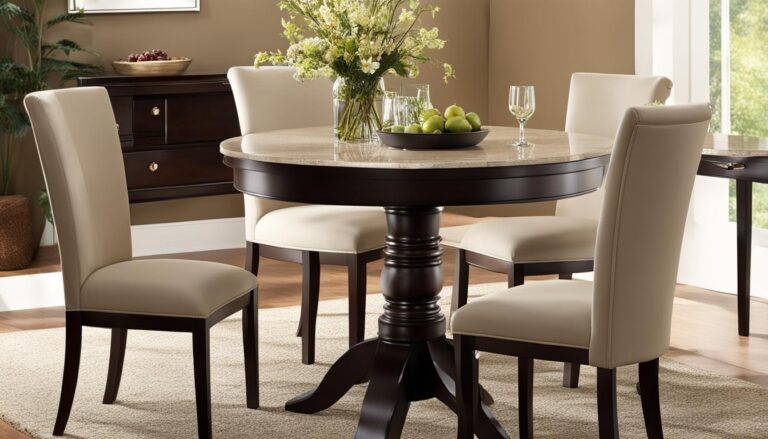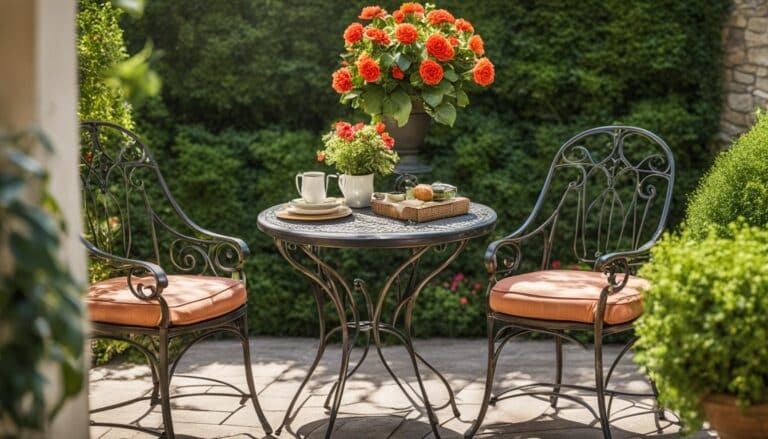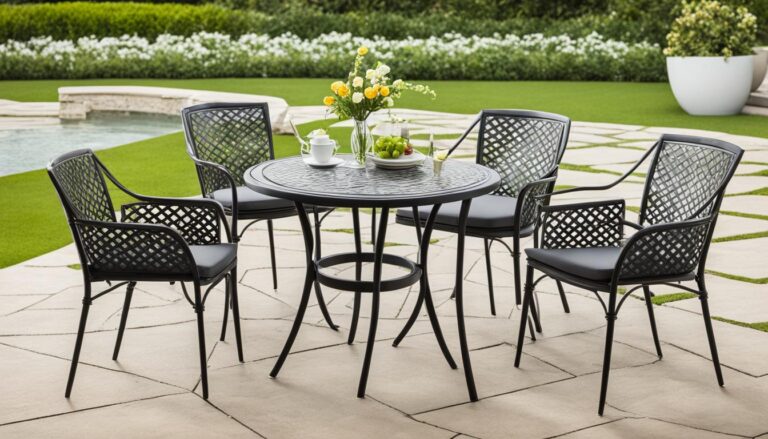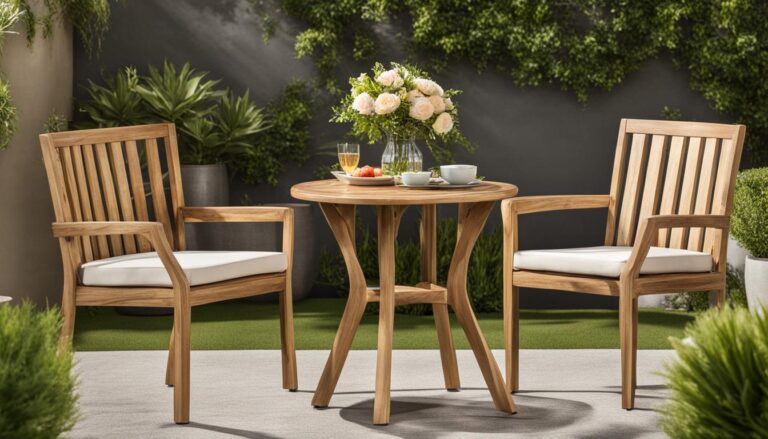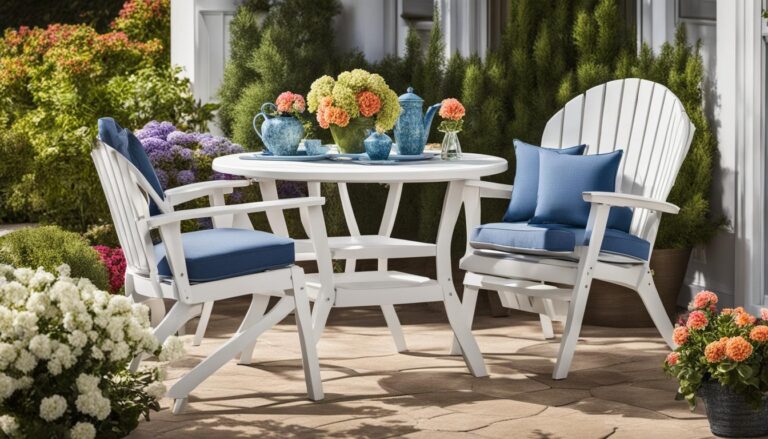Outdoor furniture covers are an essential investment for protecting your outdoor furniture from the elements. However, over time they can accumulate dirt, stains, and mildew. Cleaning your outdoor furniture covers is necessary to keep them looking their best and prolong their lifespan.
In this article, we will provide you with easy steps and tips on how to clean outdoor furniture covers effectively. From preparing for cleaning to choosing the right cleaning products and techniques, we’ve got you covered.
Key Takeaways:
- Cleaning your outdoor furniture covers is necessary to maintain their appearance and longevity.
- Regular cleaning schedules, using protective covers, and avoiding harsh weather conditions can prolong the life of your outdoor furniture covers.
- Choosing the right cleaning products and techniques for different types of materials can help you achieve the best results.
Why Cleaning Outdoor Furniture Covers is Important
Outdoor furniture covers are exposed to various elements that can cause damage, such as sun, rain, wind, dust, and dirt. Over time, these factors can cause covers to become stained, faded, or even develop mildew or mold. Regularly cleaning your outdoor furniture covers is essential to maintaining their appearance and ensuring their longevity.
By following best practices for cleaning, you can prevent damage and extend the life of your covers. Additionally, clean covers provide a fresh and inviting look to your outdoor living spaces. Nobody wants to sit on dirty and stained furniture, right?
So, take some time to clean your outdoor furniture covers, and enjoy the benefits of having an attractive and well-maintained outdoor area.
Preparing for Cleaning
Before you begin cleaning your outdoor furniture covers, it’s important to prepare properly. Here’s a step-by-step guide:
- Remove any cushions or pillows from the covers and set them aside.
- Shake off any loose debris, such as dirt or leaves, from the covers. You can use a soft-bristled brush to help remove any stubborn debris.
- Inspect the covers for any stains or spots that require special attention.
- If you notice any stains, try to identify the source and determine the best cleaning solution for that specific stain.
- If you find mildew on your covers, use a solution of equal parts water and white vinegar to kill and remove it.
By taking the time to properly prepare your covers for cleaning, you’ll be able to achieve the best results and maintain the quality of your outdoor furniture.
Choosing the Right Cleaning Products
Now that you’ve prepared your outdoor furniture covers for cleaning, it’s important to choose the right cleaning products to ensure a thorough and safe cleaning process. Here are some recommended cleaning products:
| Cleaning Product | Material Compatibility | Effectiveness |
|---|---|---|
| Mild soap | Most materials, including canvas and polyester | Gentle but effective in removing dirt and stains |
| Water | Most materials, including vinyl and olefin | Effective for light cleaning and rinsing |
| Specialized outdoor fabric cleaner | Specifically formulated for outdoor fabrics | Effective in removing tough stains and protecting against future stains |
Note: Always test any cleaning product on a small, inconspicuous area first to ensure compatibility with the material of your outdoor furniture covers.
Cleaning Different Types of Outdoor Furniture Covers
When it comes to cleaning your outdoor furniture covers, it’s important to use the proper cleaning techniques for each type of material to avoid damage. Here’s a rundown of how to clean different types of outdoor furniture covers:
- Canvas: Use a soft-bristled brush to remove any loose debris, then mix mild soap with water and gently scrub with the brush. Rinse with a hose and air-dry in a shaded area.
- Vinyl: Wipe clean with a soft cloth and mild soap and water. Rinse with a hose and air-dry in a shaded area.
- Polyester: Remove any cushions and shake off loose debris. Mix mild soap with water and scrub with a soft brush. Rinse with a hose and air-dry in a well-ventilated area.
Regardless of the type of cover you have, always test a small, inconspicuous area before cleaning the entire cover to ensure the cleaning product doesn’t cause damage. Also, avoid using high-pressure washers or harsh chemicals as they can cause damage to the cover.
Removing Stains and Mildew
Stains and mildew are common issues that outdoor furniture covers face. Here are some easy steps to help you maintain and clean the covers:
| Stains | Mildew |
|---|---|
|
|
By following these simple tips, you can easily remove stains and prevent mildew growth on your outdoor furniture covers. Regular cleaning and maintenance will ensure that your covers look great and last longer.
Drying and Storing Outdoor Furniture Covers
After cleaning your outdoor furniture covers, it’s crucial to dry them properly before storing them away. Here are some best practices for drying and storing your covers:
- Hang your covers in a well-ventilated area to air-dry completely. Avoid drying them in direct sunlight to prevent fading or discoloration.
- Make sure your covers are completely dry before folding or storing them away. Any lingering moisture can lead to mold or mildew growth.
- If you need to fold your covers, do so carefully to avoid creasing or damaging them.
- Store your covers in a clean and dry space, away from any potential sources of moisture or pests. Consider using a protective cover or plastic bag to further shield them from dust and debris.
- Check on your covers periodically during storage to ensure they remain clean and dry. If you detect any signs of mold or mildew growth, take them out to dry again or consider re-cleaning them before storage.
By following these simple steps, you can help prolong the life of your outdoor furniture covers and keep them looking their best for years to come.
Maintenance Tips for Outdoor Furniture Covers
Now that you’ve learned how to clean your outdoor furniture covers, it’s important to maintain them to extend their lifespan. Here are some simple tips to keep your covers looking their best:
- Regularly brush off loose debris, like leaves and dirt, from your covers to prevent buildup and damage.
- Clean your covers at least twice a year, or more frequently if you live in a damp or humid area.
- If possible, store your covers in a dry, cool place when not in use to prevent mold or mildew growth.
- Use protective covers to shield your furniture and covers from harsh weather conditions, like heavy rain or snow.
- Check the manufacturer’s instructions for specific care recommendations and restrictions, especially for delicate or specialty covers.
By following these simple maintenance tips, you can help ensure your outdoor furniture covers stay in good condition and last for years to come.
Protecting Furniture Covers with Waterproofing Agents
One effective way to prolong the life of your outdoor furniture covers is to apply a waterproofing agent. This can be especially helpful for covers made of porous materials that are more susceptible to water damage, such as canvas or cotton blends.
To apply waterproofing agents, follow these steps:
- Clean the cover thoroughly and let it dry completely.
- Choose a waterproofing agent specifically designed for your cover’s material (such as a canvas waterproofing spray).
- Test the waterproofing agent on a small, inconspicuous area of the cover to ensure that it does not cause any discoloration or damage.
- Apply the waterproofing agent evenly over the cover, using a spray or brush, according to the manufacturer’s instructions.
- Allow the waterproofing agent to dry completely before exposing the cover to any moisture.
Applying a waterproofing agent can help protect your outdoor furniture covers against rain, snow, and other moisture. It can also help prevent mold and mildew growth, which can be harmful to both your covers and your health. Keep in mind, however, that even waterproof covers should be stored in a dry place when not in use, to avoid unnecessary wear and tear.
Cleaning Tips for Specific Materials
Knowing the specific cleaning requirements for the materials used in your outdoor furniture covers can help ensure their longevity and appearance. Here are some tips:
| Material | Cleaning Tips |
|---|---|
| PVC | Use a soft brush or cloth with mild soap and water. Avoid using abrasive cleaners or solvents. |
| Acrylic | Spot clean with a mixture of water and mild soap. Rinse thoroughly and air dry. Do not machine wash or use bleach. |
| Olefin | Vacuum regularly to remove dirt and debris. Spot clean with a solution of water and mild detergent. Rinse thoroughly and air dry. |
Always check the manufacturer’s instructions for specific cleaning recommendations for your outdoor furniture covers. If you’re unsure or have valuable or delicate covers, seek professional help for cleaning to avoid any damage.
Additional Considerations for Outdoor Furniture Covers
When it comes to cleaning your outdoor furniture covers, there are a few additional considerations to keep in mind. By following these tips, you can ensure that you are properly maintaining your covers and maximizing their lifespan:
- Avoid using abrasive cleaning tools, such as wire brushes or scouring pads, as they can damage the fabric and cause fraying.
- Check the manufacturer’s instructions for specific care guidelines, as some covers may require special treatments or cleaning products.
- If you have delicate or valuable covers, consider seeking professional help to ensure they are cleaned properly and without damage.
- Store your covers in a clean and dry space when not in use, and avoid exposing them to harsh weather conditions.
By taking these additional considerations into account, you can ensure that your outdoor furniture covers stay looking great for years to come.
Conclusion
Now that you have learned how to clean outdoor furniture covers, you can enjoy your outdoor living space with confidence and pride. Remember, regularly cleaning and maintaining your furniture covers will not only keep them looking great but also extend their lifespan.
By following the tips and techniques outlined in this article, you can easily clean covers made from various materials and remove stains and mildew. Additionally, you can use waterproofing agents to protect your covers from water damage and ensure they stay in top condition.
Always keep in mind the best practices for cleaning outdoor furniture covers, including using gentle cleaning products, avoiding abrasive tools, and air-drying them before storing. And if you have delicate or valuable covers, seek professional help to ensure they receive proper care.
With these tips and tricks, you can maintain the appearance and durability of your outdoor furniture covers and enjoy them for years to come. Happy cleaning!
FAQ
Q: How often should I clean my outdoor furniture covers?
A: It is recommended to clean your outdoor furniture covers at least once a month to prevent dirt and debris buildup.
Q: Can I use regular household cleaners to clean my outdoor furniture covers?
A: It is best to use mild soap and water or specialized outdoor fabric cleaners to avoid damaging the material of the covers.
Q: How do I remove stains from my outdoor furniture covers?
A: For common stains, such as food or beverage spills, blot the area with a mixture of mild soap and water. For more stubborn stains, consider using a specialized stain remover according to the manufacturer’s instructions.
Q: Should I air-dry or machine-dry my outdoor furniture covers?
A: It is recommended to air-dry your outdoor furniture covers in a well-ventilated area. Avoid using a dryer as it may cause shrinking or damage to the material.
Q: Can I use waterproofing agents on my outdoor furniture covers?
A: Yes, waterproofing agents can be applied to protect outdoor furniture covers from water damage. Follow the instructions on the product packaging for proper application.
Q: How do I clean specific materials, such as PVC or acrylic, on outdoor furniture covers?
A: For PVC or acrylic covers, use a mild soap and water solution and gently scrub the surface. Avoid using abrasive cleaning tools that may scratch the material.
Q: Are there any additional considerations when cleaning outdoor furniture covers?
A: Yes, it is important to check the manufacturer’s instructions for specific cleaning recommendations. Avoid using harsh chemicals or abrasive cleaners, and consider seeking professional help for delicate or valuable covers.


